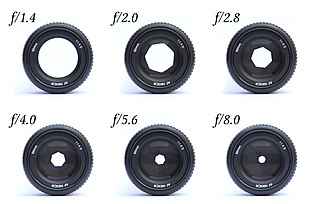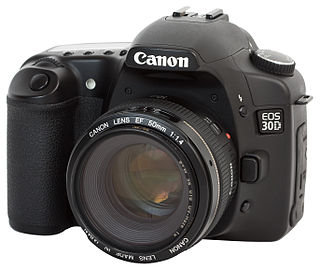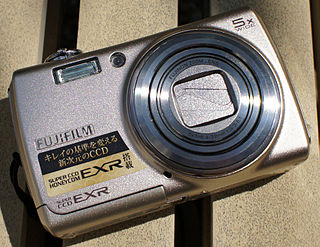
In optics, the aperture of an optical system is a hole or an opening that primarily limits light propagated through the system. More specifically, the entrance pupil as the front side image of the aperture and focal length of an optical system determine the cone angle of a bundle of rays that comes to a focus in the image plane.

In photography, shutter speed or exposure time is the length of time that the film or digital sensor inside the camera is exposed to light when taking a photograph. The amount of light that reaches the film or image sensor is proportional to the exposure time. 1⁄500 of a second will let half as much light in as 1⁄250.

A point-and-shoot camera, also known as a compact camera and sometimes abbreviated to P&S, is a still camera designed primarily for simple operation. Most use focus free lenses or autofocus for focusing, automatic systems for setting the exposure options, and have flash units built in. They are popular for vernacular photography by people who do not consider themselves photographers but want easy-to-use cameras for snapshots of vacations, parties, reunions and other events.
The Leica Digilux 1 is a digital camera developed in partnership with Panasonic, which was released in 2002, roughly the same time as the Canon PowerShot G2 and the Nikon 2000. It is the second of Leica's digital offerings. Where the original Digilux was developed in partnership with Fuji Camera, the Digilux 1 was developed jointly with Panasonic; Leica is responsible for optics, while Panasonic designs the camera electronics. According to Leica, this allows both companies to design cameras that creates a harmonious matching of lens to sensor to produce color and contrast to Leica standards.

The Sony Cyber-shot DSC-R1 is a bridge digital camera announced by Sony in 2005. It featured a 10.3 megapixel APS-C CMOS sensor, a size typically used in DSLRs and rarely used in bridge cameras. This was the first time such a large sensor was incorporated into a bridge camera. Besides the APS-C sensor, the DSC-R1 also featured a 14.3–71.5 mm Carl Zeiss Vario-Sonnar T* lens, providing for an angle of view equivalent to 24–120 mm on a full frame camera.

A bridge camera is a type of camera that fills the niche between relatively simple point-and-shoot cameras and interchangeable-lens cameras such as mirrorless cameras and single-lens reflex cameras (SLRs). They are often comparable in size and weight to the smallest digital SLRs (DSLR), but lack interchangeable lenses, and almost all digital bridge cameras lack an optical viewfinder system. The phrase "bridge camera" has been in use at least since the 1980s, and continues to be used with digital cameras. The term was originally used to refer to film cameras which "bridged the gap" between point-and-shoot cameras and SLRs.

The Canon EOS 30D is an 8.2-megapixel semi-professional digital single-lens reflex camera, initially announced on February 21, 2006. It is the successor of the Canon EOS 20D, and is succeeded by the EOS 40D. It can accept EF and EF-S lenses, and like its predecessor, it uses an APS-C sized image sensor, so it does not require the larger imaging circle necessary for 35 mm film and 'full-frame' digital cameras.

The Olympus Camedia 310 Zoom is a self-contained color digital camera system, produced by the Olympus Optical Co., Ltd.

The FujifilmFinePix F series is a line of compact digital cameras that was known for its low-light performance in 2005, with relatively low image noise and natural colors even at high ISO settings. With its relatively large, but moderate resolution Super CCD sensors, it concentrated on image quality, and low-light shooting without flash, which was mostly restricted to prosumer models at the time.

Live preview is a feature that allows a digital camera's display screen to be used as a viewfinder. This provides a means of previewing framing and other exposure before taking the photograph. In most such cameras, the preview is generated by means of continuously and directly projecting the image formed by the lens onto the main image sensor. This in turn feeds the electronic screen with the live preview image. The electronic screen can be either a liquid crystal display (LCD) or an electronic viewfinder (EVF).
The Fujifilm FinePix S200EXR is a digital bridge camera from Fujifilm introduced in July 2009.

The Fujifilm FinePix HS10 is an ultrazoom bridge camera from Fujifilm that was announced in February 2010. It is the first model of the Fujifilm FinePix HS series.
The Sony Cyber-shot DSC-TX5 is a digital still camera announced by Sony on February 18, 2010. It boasts advanced features like Backlight Correction HDR, Hand-Held Twilight aided by the Exmor R CMOS sensor, and the intelligent panorama stitching mode, called the iSweep. The camera also has a waterproof body, which also makes it dust-proof. It is also freeze-proof for up to -10 °C and shock-proof, when dropped from a height of about 1.5 meters. Sony describes it as a rugged camera.
The Sony Cyber-shot DSC-RX100 series is a high-end compact camera part of the wider Sony RX series. It started with the DSC-RX100, announced on 6 June 2012, and is part of the Cyber-shot RX line of digital cameras made by Sony. Seven annual generations have been released so far until 2019, all equipped with a one-inch 20-Megapixel image sensor and rotary knob around the lens. Filming at up to 1080p at 60fps is supported by the first three generations, the third additionally with 720p at 120fps, and up to 2160p (4K) at 30fps and 1080p at 120fps high frame rate video since the fourth.

The Sony Cyber-shot DSC-HX200V is a hyperzoom bridge digital camera that features:

Announced by Sony on August 24, 2011, and launched alongside its brother the Sony Alpha 77, the Sony Alpha 65 is the top-tier for Sony's midrange Alpha SLT camera line.

The Fujifilm FinePix HS50EXR is a DSLR styled ultra-zoom bridge camera announced by Fujifilm on January 7, 2013. It is the last model of the Fujifilm FinePix HS series. At the time of its release, it competed most closely with the Canon PowerShot SX50 HS, another ultra-zoom bridge camera with raw capability. The SX50 has 20% longer maximum effective focal length, but the HS50 has 33% more resolution on the sensor.

The Sony Cyber-shot DSC-HX50 is a hyperzoom camera with 30x optical zoom, released in 2013.

The Sony RX is the name of a range of fixed lens compact point-and-shoot digital cameras created by Sony in 2012. All cameras are equipped with Carl Zeiss lenses.






















